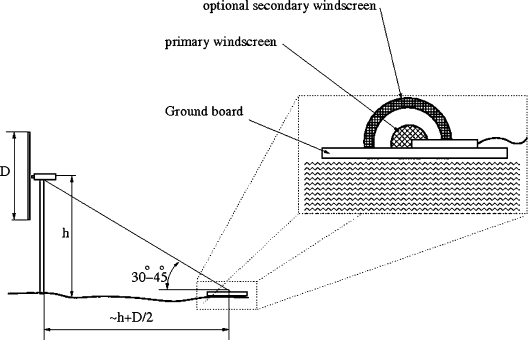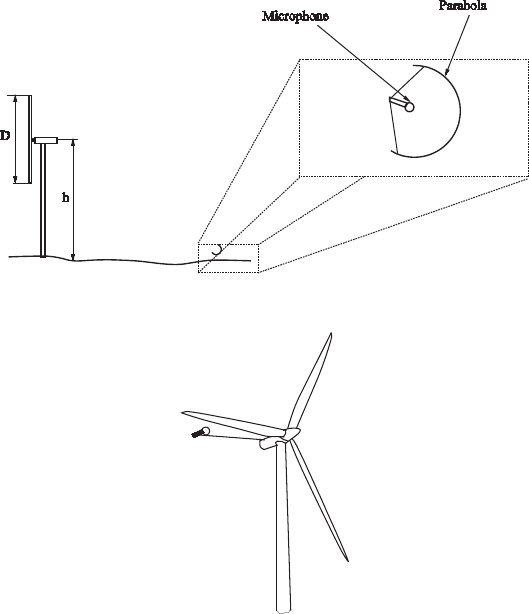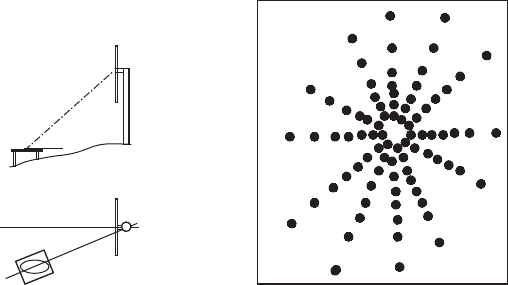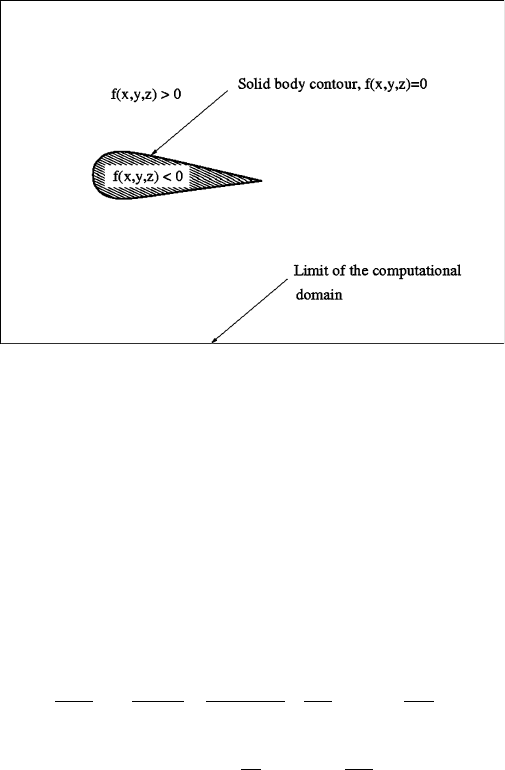Tong W. Wind Power Generation and Wind Turbine Design
Подождите немного. Документ загружается.


Wind Turbine Acoustics 165
5 Wind turbine noise measurements
There are two main categories of measurements related to wind turbine acoustics:
on-site and wind-tunnel measurements. The fi rst group gives more realistic data
since it is applied for a whole wind turbine and gives directly the noise generated
by it. The major drawbacks of the on-site measurements are the diffi culty to install
the instrumentation and the impossibility of prescribing desired fl ow conditions.
This leads also to a limited repeatability of the measurements. Wind-tunnel mea-
surements offer more control, but they have a limited size. As a consequence,
the models have to be scaled down and sometimes only parts of the wind turbine
can be studied. The scaling of the models is not straightforward, not all the non-
dimensional parameters can be preserved. Also, the background noise from the
wind tunnel is diffi cult to subtract from the measurements. A good review of the
measurement methods applicable for wind turbine noise is presented in [ 4 ].
5.1 On-site measurements
5.1.1 Ground board
The ground board consists of a fl at, acoustically hard plate with a microphone
mounted horizontally, at the center of the plate [ 4 ]. The microphone has to be directed
towards the turbine tower and is covered by a wind screen (see Fig. 11 ). The major
advantage of using a ground board is that it diminishes the wind-induced noise and
that the refl ections from the ground are independent from the site. To remove the
effect of refl ections 6 dB is subtracted from the measured spectra at all frequencies.
5.1.2 Acoustic parabola
Acoustic parabolas (see Fig. 12 ) refl ect and focus the acoustic waves in their focal
point where a microphone registers the signal. The amplifi cation depends on the
Figure 11: Ground board used for noise measurements (after [ 4 ]).

166 Wind Power Generation and Wind Turbine Design
angle of incidence, it amplifi es more the noise coming from the direction where
the parabola is aimed to.
In this way noise coming from a certain part of the wind turbine can be local-
ized. If one is interested in the noise coming from a certain part of the rotating
blades (e.g. tip region), the measured signal has to be windowed to post process
only the data corresponding to the passage of the blade over the measurement spot.
The amplifi cation depends also on the wavelength of the acoustic waves, large
wavelengths compared to the size of the parabola reduces the spatial accuracy.
5.1.3 Proximity microphone
Ground boards and acoustic parabolas are used far from the wind turbine. Prox-
imity microphones (see Fig. 13 ) are installed close to the noise sources, either on
the blades themselves or close to the blades on fi xed devices. The disadvantage
of mounting the proximity microphones directly on the blades is that it will be
exposed to higher speeds of the air fl ow resulting in higher wind-induced noise.
If the microphone is not co-rotating with the blade a time-windowing technique
has to be used to collect data only when the noise sources are in the vicinity of the
Figure 12: Acoustic parabola used for noise measurements.
Figure 13: Proximity microphone used for noise measurements.

Wind Turbine Acoustics 167
microphone. The spatial accuracy of the proximity microphones depends on the
distance from the source, but, unlike acoustic parabolas, is independent of the
acoustic wavelength.
5.1.4 Acoustic antenna
Acoustic antennas are composed by a set of microphones in a row or in a matrix
which can be mounted on a ground plate or in the proximity of the wind turbine.
By computing correlations of the signals provided by different microphones, the
location of the acoustic sources can be determined.
Oerlemans et al. [ 16 ] used for example an array of 148 microphones mounted
on a board of 15 m × 18 m. The array had an elliptic shape to account for the cir-
cular motion of the blades and for the tilted angle of the board (see Fig. 14 ). Cross-
correlating the microphones data made possible to determine the distribution of
the noise sources in the rotor plane and along the rotor blades (individually for the
three blades). It was observed that most of the noise sources are located on the
right-hand side of the rotor plane, indicating that most of the noise is generated
during the downward motion of the blades. Furthermore, the contribution of the
hub was also clearly visible.
5.2 Wind-tunnel measurements
Wind tunnels have the advantage of providing better controllable fl ow conditions
and thus are preferred for systematic studies. Due to their size limitations, how-
ever, wind tunnels are limited to downscaled model studies. The large-scale facil-
ity at the National Renewable Energy Laboratory in the USA is equipped with
a wind tunnel with a measurement cross section of 24.4 × 36.6 m
2
which made
possible to carry out fl ow measurements on a full-scale (10 m rotor diameter) wind
turbine [ 17 ]. The wind tunnel, however, is not anechoic, thus is not well suited for
acoustic measurements.
Figure 14: Sketch of the board position (left) and the arrangement of the micro-
phones on the board (right) (after [ 16 ]).

168 Wind Power Generation and Wind Turbine Design
Brooks et al. [ 18 ] measured the fl ow and the acoustic pressure around a set of
NACA 0012 airfoils with different chord lengths in an anechoic chamber. Eight
microphones have been used for the noise measurements. Based on the measure-
ment data, semi-empirical models have been developed to predict airfoil self-noise
(see Section 6.2).
In Europe there are two anechoic wind tunnels at the University of Oldenburg
and at the National Aerospace Laboratory (NRL) in the Netherlands [ 4 ]. These
facilities have been used also for the study of the airfoil self-noise, as well as for
the study of the noise due to turbulent infl ow.
The major drawback of wind-tunnel measurements is the self-noise of the wind
tunnel itself. The errors due to the background noise can be reduced for rotating
sources by using tracking methods. For stationary sources (e.g. airfoil cross sec-
tions) the error due to the background noise can be reduced by using multiple
microphones and cross-correlating the signals at different observer positions.
Fujii et al. [ 19 ] studied the noise generated by the interaction of the rotor blades
with the wakes of wind turbine towers. Towers with circular, elliptical and square
cross sections have been considered. Their measurements showed that the tower
with a slender elliptic cross section was the quietest, the loudest being the one with
the square cross section.
6 Noise prediction
The solution of the compressible Navier-Stokes equations includes inherently also
the generation and propagation of the acoustic pressure waves. This direct compu-
tational approach, however, involves several drawbacks, which make it applicable
only for relatively simple cases and to small Reynolds numbers [20 − 22]. One issue
is the small magnitude of the acoustic quantities (acoustic pressure and density
fl uctuations) as compared to the hydrodynamic quantities of the fl ow. The low-
amplitude acoustic fl uctuations require discretization schemes with high accu-
racy which are computationally demanding. Also, the timesteps are limited by the
sound speed and not the convection speed as it is the case of incompressible fl ow
simulations. As a result, there was a need to develop aeroacoustic models.
Lighthill [ 23 ] was the fi rst to derive a model for aerodynamically generated
sound. By rearranging the continuity and momentum equations he obtained the
following non-homogeneous wave equation for the acoustic density:
2
22
2
0
2
()
''
ij
ii i j
uu
c
xx xx
t
r
rr
∂
∂∂
−=
∂∂ ∂∂
∂
(10 )
where r ′ = r − r
0
is the acoustic density fl uctuation defi ned as the departure from
ambient conditions, and c
0
is the sound speed in the undisturbed ambient medium.
In the derivation of eqn ( 10 ) it was assumed that the ambient conditions are con-
stant and viscosity effects have been neglected. Equation ( 10 ) is called the Light-
hill analogy and describes the propagation (left-hand side, LHS) and generation
(right-hand side, RHS) of sound by the fl uid fl ow. The term on the RHS is the

Wind Turbine Acoustics 169
second derivative of the Lighthill stress tensor, T
ij
= r u
i
u
j
, which acts as a source
of quadrupole type.
Lighthill's analogy does not take into account the noise generated by solid
surfaces. To remedy this defi ciency, Ffowcs Williams and Hawkings (cited in
[ 24 ]) extended Lighthill’s analogy by representing a solid object by a sur-
face S defi ned as f ( t,x,y,z ) = 0 (see Fig. 15 ) and extending the fl uid motion
also into the object domain but restricting the velocity to the speed of the
object itself. Using the generalized function theory the following equation has
been derived:
2
22
2
0
2
0
()
''
()
()
ij
ij
ii i j i j
i
i
uu
f
cpf
xx xx x x
t
f
uf
tx
r
rr
d
rd
⎛⎞
∂
∂∂ ∂ ∂
−= −
⎜⎟
∂∂ ∂∂ ∂ ∂
∂
⎝⎠
⎛⎞
∂∂
+
⎜⎟
∂∂
⎝⎠
(11 )
The fi rst term on the right-hand side is identical to the RHS of eqn ( 10 ) and is
the Lighthill stress tensor. The second term on the RHS is proportional to the stress
tensor p
ij
, refl ecting the force which the object exerts on the fl uid and it has a
dipole character. The third term on the RHS is a monopole term and is proportional
to the acceleration of the fl uid by the non-stationary solid surface.
Based on these theoretical models, researchers deduced semi-empirical models
used for the prediction of the noise generated by non-rotating and rotating air-
foils. The fi rst models were developed to predict the noise generated by airplane
wings and helicopter rotors. Later, these models were adapted for wind turbine
applications. With the increase of the available computational power and evolu-
tion of the aeroacoustic theory more and more complex models were developed
Figure 15: The value of the shape function in the solid and fl uid regions.

170 Wind Power Generation and Wind Turbine Design
during the years. Lowson (cited in [ 4 ]) divided the prediction models in three
categories:
The Category I models predict the global emitted noise as a function of main •
wind turbine parameters, like rated power, rotor diameter, blade area, tip
speed, etc.
The Category II models are semi-empirical relationships which predict the total •
sound pressure level and spectral shape taking into account the various noise
generation mechanisms.
The Category III models are based on a detailed description of the rotor geometry •
and aerodynamics and give detailed information about the acoustic fi eld.
6.1 Category I models
These models are the simplest ones. Based on simple algebraic relations they
predict the emitted sound power level as functions of the wind turbine main
parameters. Table 1 lists the category I models as it is summarized by Wagner
et al. [ 4 ]. In Table 1 L
WA
is the total A-weighted sound power level, P
WT
the rated
power of the turbine, D the rotor diameter, L
pA
the A-weighted sound pressure
level at a monitoring point located at a distance of r
0
from the tower base, V
tip
the
tip speed, n
b
the number of the blades, A
b
the blade area, A
r
the rotor area, C
T
the
axial force coeffi cient, r the hub − observer distance. C
i
are empirical parameters
having different values in different references.
These Category I models are simple and fast, however they are by far not univer-
sal. As a consequence, these models were rapidly outranked by the computationally
not much more expensive, but more accurate Category II models.
6.2 Category II models
The models belonging to this category are semi-empirical and consist of a set
of models for the noise generation mechanisms listed in Section 4.1.2. Based on
Lighthill's and Ffowcs Williams − Hawkings theory and experimental measurements
Table 1: Category I models [ 4 ].
No. Model
1
WA 10 WT
10 log 50LP=+
2
WA 10
22 log 72LD=+
3
b
pA 1 10 tip 2 10 b 3 10 T 4 10 5 10 6
r
log log log log log
A
D
LC VC n C CC C DC
Ar
⎛⎞
=+ ++−−
⎜⎟
⎝⎠

Wind Turbine Acoustics 171
algebraic relationships are deduced to model both the emitted sound power level
and sound spectrum. There are a multitude of models in the literature for each
noise generation mechanism, in the followings the most widespread models
being presented.
6.2.1 Trailing edge noise
Grosvelds model (cited in [ 4 ]) is based on a frozen turbulent pattern convected
downstream over the trailing edge and predicts the A-weighted sound pressure
level as:
5
pA 10 b
2
10 log ( )
S
UD
LnKfC
r
d
⎛⎞
Δ
=++
⎜⎟
⎝⎠
(12)
The shape of the spectrum is given by
4
4 1.5
10
max max
''
( ) 10log 0.5
St St
Kf
St St
−
⎧⎫
⎡⎤
⎛⎞⎛⎞
⎪⎪
⎢⎥
=+
⎨⎬
⎜⎟⎜⎟
⎝⎠⎝⎠
⎢⎥
⎪⎪
⎣⎦
⎩⎭
( 13)
and the Strouhal numbers are defi ned as
max
' , 0.1
f
St St
U
d
==
(14 )
The empirical constant is C = 5.44 dB and the directivity factor is determined as:
[]
2
2
2
C
sin / 2
(, ) sin
(1 cos ) 1 ( ) cos
D
MMM
q
qy y
qq
=
++−
(15 )
Thus the sound pressure level depends on the fi fth power of the velocity. Brooks
et al. [ 18 ] developed a more complex model to predict the trailing edge noise,
accounting for the length of the blade segment, angle of attack and separating the
contributions from the suction end pressure sides:
p, p,s p,p
/10 /10 /10
p10
10 log (10 10 10 )
LLL
L
a
=++
(16 )
where the individual contributions have the form:
*5
p, 10
2
peak
10 log
ii
iii
MsD St
LKC
St
r
d
⎛⎞
⎛⎞
Δ
=++
⎜⎟
⎜⎟
⎝⎠
⎝⎠
(17 )
d
i
being the displacement thickness, M the Mach number, Δ s the chord length,
–
D
the directivity function (given by a similar relationship to eqn ( 15 )), K
i
are shape
functions for the spectra and C
i
empirical constants. The peak Strouhal numbers
St
peak
have also empirical values.

172 Wind Power Generation and Wind Turbine Design
Lowson [ 9 ] based his model on the work of Brooks et al. [ 18 ]:
(
)
*5
p10
10 log 128.5
sM
LKf
r
d
⎛⎞
=++
⎜⎟
⎝⎠
(18)
Thus the major difference is that the directivity effects are neglected. The spectral
shape function is also simplifi ed:
2
2.5 2.5
10
peak peak
( ) 10log 4 1
ff
Kf
ff
−
⎡⎤
⎛⎞
⎛⎞ ⎛⎞
⎢⎥
⎜⎟
=+
⎜⎟ ⎜⎟
⎢⎥
⎜⎟
⎝⎠ ⎝⎠
⎝⎠
⎢⎥
⎣⎦
(19 )
6.2.2 Separation-stall noise
The literature lacks specifi c models for the separation-stall noise. Brooks et al.
[ 18 ] used the same theory to predict separation-stall noise as the one used for the
trailing edge noise presented in the previous section.
6.2.3 Tip vortex formation noise
For the tip vortex noise Brooks et al. proposed the following model:
322
TV TV
p10 1 2 3
2
peak 0
Re
10 log ( )
Re
MM l D
St
LKKK
St
r
a
⎛⎞
⎛⎞
⎛⎞
=+++
⎜⎟
⎜⎟
⎜⎟
⎝⎠
⎝⎠
⎝⎠
( 20 )
where the Strouhal number and M
TV
are based on the tip vortex parameters,
TV TV
TV
TV 0
,.
fl U
St M
Uc
==
6.2.4 Boundary layer vortex shedding noise
This noise source is modeled by Brooks et al. [ 18 ] similarly to the trailing
edge noise:
5
p
p10 1 2 3
2
peak 0
Re
10 log ( )
Re
MsD
St
LKKK
St
r
d
a
⎛⎞
⎛⎞
Δ
⎛⎞
=+++
⎜⎟
⎜⎟
⎜⎟
⎝⎠
⎝⎠
⎝⎠
(21 )
where the three terms after the logarithm are empirical functions determining the
spectrum shape K
1
, and the infl uence of the Reynolds number K
2
and the angle of
attack K
3
.
6.2.5 Trailing edge bluntness vortex shedding noise
Grosveld developed two models for the bluntness shedding noise depending on
the ratio of the trailing edge thickness, t
*
, and the displacement thickness of the
boundary layer, d
*
. If t
*
/ d
*
> 1.3

Wind Turbine Acoustics 173
6* 2 2
pA 10 b
26
sin ( )sin ( )
10 log ( )
(1 cos )
Ut s
LnKfC
rM
qy
q
⎛⎞
Δ
=++
⎜⎟
+
⎝⎠
( 22 )
with the peak frequency:
peak
*
0.25
/4
U
f
t d
=
+
(23 )
If t
*
/ d
*
< 1.3
[]
5* 2 2
pA 10 b
23 2
c
sin ( / 2)sin ( )
10 log ( )
(1 cos ) 1 ( ) cos
Ut s
LnKfC
rM MM
qy
qq
⎛⎞
Δ
=++
⎜⎟
++−
⎝⎠
(24)
and peak frequency:
peak
*
0.1
U
f
t
=
(25 )
The spectral shapes K ( f ) are empirical functions.
Brooks et al. [ 18 ] used a single model for the trailing edge bluntness noise:
* 5.5 * *
p10 1 2
2**
peak
avg avg
10 log , , ,
tM sD t t St
LKK
St
r
yy
dd
⎛⎞⎛ ⎞
⎛⎞
Δ
=++
⎜⎟⎜ ⎟
⎜⎟
⎝⎠
⎝⎠⎝ ⎠
(26 )
where y is the angle of the trailing edge and
***
avg p s
05ddd = . ( + ) .
6.2.6 Noise due to atmospheric turbulence
The atmospheric turbulence is highly dependent on weather conditions, the geom-
etry of the landscape and ground roughness. As a consequence, the noise gener-
ated by the interaction of onfl ow turbulence and the blades is the most diffi cult to
model. Indeed, the models used for the turbulence effects are very sensitive to the
choice of appropriate turbulence scales. As an example, Glegg et al. [ 25 ] reports
that using turbulent length-scales from the atmospheric boundary layer leads to an
over-prediction of the noise levels, while assuming the turbulent length-scales to
be of the order of the blade chord gave much better results.
Amiet [ 7 ] did a pioneering work deriving a theoretical expression for the far-
fi eld acoustic spectral density produced by an airfoil obtaining good predictions of
experimental data.
One of the earliest models for the noise generated by infl ow turbulence for wind
turbines is developed by Grosveld (cited in [ 4 ]). This model is valid only for low
frequencies because it is based on the assumption that the noise is generated by a
point source located at the hub. Furthermore, neutral stability conditions and nega-
tive temperature gradient are assumed for the atmosphere. The sound pressure
level is given by:
2
22
4
b
p10
22
0
sin ( )
10 log ( )
n
wUCR
LKfC
rc
r
⎛⎞
=++
⎜⎟
⎜⎟
⎝⎠
f
(27 )

174 Wind Power Generation and Wind Turbine Design
where K ( f ) (the shape of the spectrum) and C are determined empirically, U =
Ω R
ref
and the peak frequency is given by:
peak
16.6
0.7
U
f
hR
=
−
( 28)
The reference chord location is at 30% of the blade length from the tip of the blade
and the root mean square of the turbulence intensity is given by:
2/3
2
2
r
r
2
wr r
( 0.014 )
hw
ww
VRw w
−
⎛⎞
=
⎜⎟
−
⎝⎠
(29 )
where V
w
is the wind speed, h the height above the ground, and the turbulence
intensity is:
10
1.185 0.193log
2 0.353 1/
rw
0.2(2.18 )
h
wVh
−
−
=
(30 )
Lowson [ 9 ] derived a model based on Amiet's work [ 7 ]. Contrary to Amiet, Low-
son has a single formula for the high- and low-frequency regimes, by introducing
a correction term:
2
22 3 3 2 7/3
0IT
LF
p10 10
2
LF
(1 )
10 log 58.4 10 log
1
cl sM wk k
K
L
K
r
r
−
⎛⎞
⎛⎞
Δ+
=++
⎜⎟
⎜⎟
⎜⎟
+
⎝⎠
⎝⎠
(31 )
where K
LF
is the low-frequency correction factor, k = ( π fC )/ U , U includes
contributions from the wind speed as well,
22
w
()(2/3)UR V=Ω +
, and M = U / c
0
.
6.2.7 Sample results
Moriarty and Migliore [ 26 ] used Category II models to predict the acoustic fi eld
generated by two-dimensional airfoils and from a full-scale wind turbine. Except
the infl ow turbulence noise the models from Brooks et al. [ 18 ] have been used. The
infl ow turbulence noise model was adapted from Lowson [ 9 ]. The tower − wake
interaction and propagation effects are neglected. As it regards the directivity, it
is assumed that all sources are propagated in the wind direction with a speed cor-
responding to 80% of the average wind speed. For the airfoil cross sections good
agreements were obtained for high frequencies (around 3 kHz), while at lower
frequencies the sound pressure levels were overpredicted by as much as 6 dB (see
Fig. 16 ). For the full-scale turbine it was observed that the turbulence inlet noise
had the largest contribution to the overall sound pressure level. The second most
important noise source was found to be the blunt trailing edge noise or the laminar
vortex shedding noise, depending on the wind speed.
6.3 Category III models
The models belonging to this category take into account the complex three-
dimensional and time-dependent distribution of the acoustic sources. A recent
